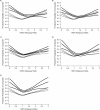Should gestational weight gain recommendations be tailored by maternal characteristics?
- PMID: 21633118
- PMCID: PMC3167680
- DOI: 10.1093/aje/kwr064
Should gestational weight gain recommendations be tailored by maternal characteristics?
Abstract
The authors tested whether the relation between gestational weight gain (GWG) and 5 adverse pregnancy outcomes (small-for-gestational-age (SGA) birth, large-for-gestational-age (LGA) birth, spontaneous preterm birth, indicated preterm birth, and unplanned cesarean delivery) differed according to maternal race/ethnicity, smoking, parity, age, and/or height. They also evaluated whether GWG guidelines should be modified for special populations by studying GWG and risk of at least 1 adverse outcome within different subgroups. Data came from a cohort of 23,362 normal-weight mothers who delivered singletons at Magee-Womens Hospital in Pittsburgh, Pennsylvania (2003-2008). Adequacy of GWG was defined as observed GWG divided by recommended GWG. The synergy analysis found that the combination of smoking, black race/ethnicity, primiparity, or short height with poor GWG was associated with an excess risk of SGA birth, while high GWG combined with each of these characteristics diminished risk of LGA birth in comparison with the same GWG among the women's counterparts. Nevertheless, there were no significant or meaningful differences in the risk of at least 1 adverse outcome between the GWG recommended by the Institute of Medicine in 2009 and the GWG that minimized risk of the composite outcome. These findings do not support the tailoring of GWG guidelines on the basis of a mother's smoking status, race/ethnicity, parity, age, or height among normal-weight women.
Figures






References
-
- Institute of Medicine. Weight Gain During Pregnancy: Reexamining the Guidelines. Washington, DC: National Academies Press; 2009. National Academy of Sciences. - PubMed
-
- Institute of Medicine. Nutrition During Pregnancy. Washington, DC: National Academy Press; 1990. National Academy of Sciences.
-
- Abrams BF, Laros RK., Jr Prepregnancy weight, weight gain, and birth weight. Am J Obstet Gynecol. 1986;154(3):503–509. - PubMed
-
- Nielsen JN, O'Brien KO, Witter FR, et al. High gestational weight gain does not improve birth weight in a cohort of African American adolescents. Am J Clin Nutr. 2006;84(1):183–189. - PubMed
-
- Nohr EA, Vaeth M, Baker JL, et al. Pregnancy outcomes related to gestational weight gain in women defined by their body mass index, parity, height, and smoking status. Am J Clin Nutr. 2009;90(5):1288–1294. - PubMed
Publication types
MeSH terms
Grants and funding
LinkOut - more resources
Full Text Sources
Medical

